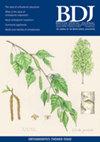Endodontic access cavity preparation: challenges and recent advancements
IF 2
4区 医学
Q2 DENTISTRY, ORAL SURGERY & MEDICINE
引用次数: 0
Abstract
Odontogenic pain from various dental issues significantly impacts quality of life, necessitating effective treatment during emergency dental care. Endodontic access cavity preparation is essential for alleviating symptoms and preventing further infection. This procedure aims to achieve symptom relief while conserving as much tooth structure as possible. This paper discusses the importance of proper endodontic access, emphasising the balance between adequate disinfection and preserving tooth integrity. It also identifies challenges in endodontic access cavity preparation. This study reviews existing literature on endodontic access, examining different approaches to access cavity preparation and the tools and techniques used. Factors affecting access difficulty, including tooth anatomy, patient-related challenges and operator skills, are evaluated, alongside advancements in imaging and instrumentation. The review shows conservative techniques, like minimally invasive access cavities, which helps to preserve tooth structure but requires advanced skills and may risk incomplete disinfection. Cone beam computed tomography (CBCT) aids in complex cases, improving canal location accuracy. Operator skills and proper equipment are key to success. Traditional cavities offer better access but can weaken the tooth, while conservative approaches maintain structure but demand more expertise. Imaging tools, including CBCT, are beneficial for complex anatomy but can be costly. To conclude, effective endodontic access cavity preparation requires a balanced approach tailored to each case. While conservative methods offer advantages in preserving tooth structure, their success depends on operator expertise and equipment. Incorporating imaging advancements like CBCT can enhance access success, especially in anatomically complex cases, but careful assessment of case complexity remains crucial.

根管治疗通路洞准备:挑战与最新进展
本文章由计算机程序翻译,如有差异,请以英文原文为准。
求助全文
约1分钟内获得全文
求助全文
来源期刊

British Dental Journal
医学-牙科与口腔外科
CiteScore
3.10
自引率
15.40%
发文量
1096
审稿时长
4-8 weeks
期刊介绍:
The role of the BDJ is to inform its readers of ideas, opinions, developments and key issues in dentistry - clinical, practical and scientific - stimulating interest, debate and discussion amongst dentists of all disciplines. All papers published in the BDJ are subject to rigorous peer review.
 求助内容:
求助内容: 应助结果提醒方式:
应助结果提醒方式:


